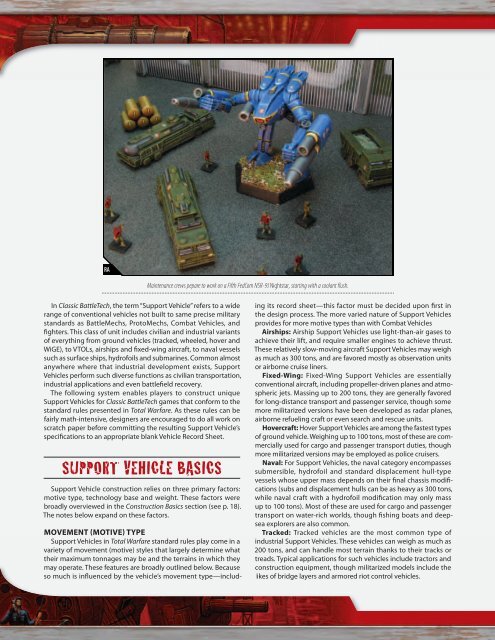the shape of things to come
the shape of things to come
the shape of things to come
Create successful ePaper yourself
Turn your PDF publications into a flip-book with our unique Google optimized e-Paper software.
RA RA<br />
In Classic BattleTech, <strong>the</strong> term “Support Vehicle” refers <strong>to</strong> a wide<br />
range <strong>of</strong> conventional vehicles not built <strong>to</strong> same precise military<br />
standards as BattleMechs, Pro<strong>to</strong>Mechs, Combat Vehicles, and<br />
fi ghters. This class <strong>of</strong> unit includes civilian and industrial variants<br />
<strong>of</strong> everything from ground vehicles (tracked, wheeled, hover and<br />
WiGE), <strong>to</strong> VTOLs, airships and fi xed-wing aircraft, <strong>to</strong> naval vessels<br />
such as surface ships, hydr<strong>of</strong>oils and submarines. Common almost<br />
anywhere where that industrial development exists, Support<br />
Vehicles perform such diverse functions as civilian transportation,<br />
industrial applications and even battlefi eld recovery.<br />
The following system enables players <strong>to</strong> construct unique<br />
Support Vehicles for Classic BattleTech games that conform <strong>to</strong> <strong>the</strong><br />
standard rules presented in Total Warfare. As <strong>the</strong>se rules can be<br />
fairly math-intensive, designers are encouraged <strong>to</strong> do all work on<br />
scratch paper before committing <strong>the</strong> resulting Support Vehicle’s<br />
specifi cations <strong>to</strong> an appropriate blank Vehicle Record Sheet.<br />
SUPPORT VEHICLE BASICS<br />
Support Vehicle construction relies on three primary fac<strong>to</strong>rs:<br />
motive type, technology base and weight. These fac<strong>to</strong>rs were<br />
broadly overviewed in <strong>the</strong> Construction Basics section (see p. 18).<br />
The notes below expand on <strong>the</strong>se fac<strong>to</strong>rs.<br />
MOVEMENT (MOTIVE) TYPE<br />
Support Vehicles in Total Warfare standard rules play <strong>come</strong> in a<br />
variety <strong>of</strong> movement (motive) styles that largely determine what<br />
<strong>the</strong>ir maximum <strong>to</strong>nnages may be and <strong>the</strong> terrains in which <strong>the</strong>y<br />
may operate. These features are broadly outlined below. Because<br />
so much is infl uenced by <strong>the</strong> vehicle’s movement type—includ-<br />
Maintenance crews pepare <strong>to</strong> work on a Fifth FedCom NSR-9J Nightstar, starting with a coolant fl ush.<br />
ing its record sheet—this fac<strong>to</strong>r must be decided upon fi rst in<br />
<strong>the</strong> design process. The more varied nature <strong>of</strong> Support Vehicles<br />
provides for more motive types than with Combat Vehicles<br />
Airships: Airship Support Vehicles use light-than-air gases <strong>to</strong><br />
achieve <strong>the</strong>ir lift, and require smaller engines <strong>to</strong> achieve thrust.<br />
These relatively slow-moving aircraft Support Vehicles may weigh<br />
as much as 300 <strong>to</strong>ns, and are favored mostly as observation units<br />
or airborne cruise liners.<br />
Fixed-Wing: Fixed-Wing Support Vehicles are essentially<br />
conventional aircraft, including propeller-driven planes and atmospheric<br />
jets. Massing up <strong>to</strong> 200 <strong>to</strong>ns, <strong>the</strong>y are generally favored<br />
for long-distance transport and passenger service, though some<br />
more militarized versions have been developed as radar planes,<br />
airborne refueling craft or even search and rescue units.<br />
Hovercraft: Hover Support Vehicles are among <strong>the</strong> fastest types<br />
<strong>of</strong> ground vehicle. Weighing up <strong>to</strong> 100 <strong>to</strong>ns, most <strong>of</strong> <strong>the</strong>se are commercially<br />
used for cargo and passenger transport duties, though<br />
more militarized versions may be employed as police cruisers.<br />
Naval: For Support Vehicles, <strong>the</strong> naval category encompasses<br />
submersible, hydr<strong>of</strong>oil and standard displacement hull-type<br />
vessels whose upper mass depends on <strong>the</strong>ir fi nal chassis modifi -<br />
cations (subs and displacement hulls can be as heavy as 300 <strong>to</strong>ns,<br />
while naval craft with a hydr<strong>of</strong>oil modifi cation may only mass<br />
up <strong>to</strong> 100 <strong>to</strong>ns). Most <strong>of</strong> <strong>the</strong>se are used for cargo and passenger<br />
transport on water-rich worlds, though fi shing boats and deepsea<br />
explorers are also common.<br />
Tracked: Tracked vehicles are <strong>the</strong> most common type <strong>of</strong><br />
industrial Support Vehicles. These vehicles can weigh as much as<br />
200 <strong>to</strong>ns, and can handle most terrain thanks <strong>to</strong> <strong>the</strong>ir tracks or<br />
treads. Typical applications for such vehicles include trac<strong>to</strong>rs and<br />
construction equipment, though militarized models include <strong>the</strong><br />
likes <strong>of</strong> bridge layers and armored riot control vehicles.


